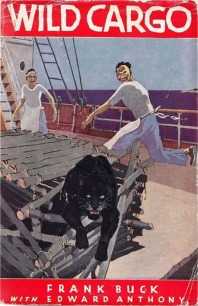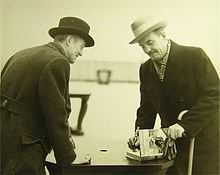Wild Cargo (book)
 first edition cover (1932) | |
| Author |
Frank Buck Edward Anthony |
|---|---|
| Country | United States |
| Language | English |
| Genre | non-fiction |
| Publisher | Simon and Schuster |
Publication date | 1932 |
| Media type | Print (Hardback) |
| Pages | 244 |
| Preceded by | Bring 'Em Back Alive |
| Followed by | Fang and Claw |

Wild Cargo was Frank Buck’s second book, a best seller. Buck continued his tales of his adventures capturing exotic animals.[1] Writing with Edward Anthony, Buck related many of his experiences working with jungle creatures.
Chapters
Buck was a keen observer and student of animal psychology and includes occasional bits of shocking realism, for example in "Killer of Killers" he relates the story of a man-eating tiger that could be trapped by only one kind of bait: human flesh. In "Coiled Lightning" he describes an encounter with a hungry python. In "Spitting Cobra" he tells of a painful meeting with one of the most unpleasant snakes in the world. In "The Patsy" Buck tells the story of a young female elephant who had nothing but bad luck; in "Black Fury" of a leopard who escaped from his cage on shipboard; and in "Terrible Tusks" of a tremendous conflict, witnessed by his native assistant, between two bull elephants contending for the mastery of a herd of females. "A Bear In Time" is the story of a destructive honey bear that Buck used to rid himself of a bore, who had threatened to move into his house. “Animal Magic” describes native medicines: tigers' gall bladders, hairs from elephants' tails and leopards' shoulder bones. “Striped Demon,” the final chapter, is the thrilling story of an attack on Buck by a tiger he is trying to film.
Critical reception
"Enough legitimate action and suspense to make a dozen average jungle motion picture films" [2]
References
- ↑ Lehrer, Steven (2006). Bring 'Em Back Alive: The Best of Frank Buck. Texas Tech University press. pp. x–xi. ISBN 0-89672-582-0.
- ↑ RL Duffus. All of the Inhabitants of Noah’s Ark. New York Times. May 29, 1932